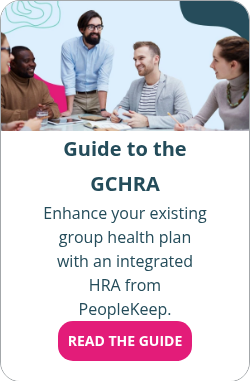What are the group coverage HRA employee classes?
By Elizabeth Walker on January 27, 2025 at 9:45 AM
The group coverage health reimbursement arrangement (GCHRA) allows employers to supplement traditional group plans while maintaining budget control. Employers looking to offer a GCHRA can take advantage of a customization feature: job-based employee classes. Employee classes allow you to tailor your GCHRA’s eligibility rules and allowance amounts to offer custom benefits to your diverse workforce.
Leveraging employee classes is a surefire way to help employers design their health benefits more effectively to attract and retain talented staff members. But first, you must understand the employee classes and how they work.
In this blog post, you’ll learn:
- How the GCHRA works, including its features, benefits, and customizations.
- What the employee classes are, and how they can help tailor health benefits to different groups in your workforce.
- How to structure eligibility and allowance amounts within GCHRA classes to attract and retain top talent.
What is a GCHRA, and how does it work?
A GCHRA, also known as an integrated HRA, is a tax-free health benefit for employers of all sizes that offer traditional group health insurance. With a GCHRA, you can reimburse your employees for qualified out-of-pocket medical costs their group health plan doesn’t cover or fully cover. Eligible expenses include prescription drugs, deductibles, coinsurance, copays, and more.
Below are more details about how the GCHRA works:
- With a GCHRA, you set a monthly or annual allowance that your employees can spend on healthcare costs. Once they show proof of an eligible expense, you reimburse them tax-free up to their allowance amount.
- The integrated HRA has no minimum or maximum contribution limits. You can offer as little or as much allowance as your budget allows.
- Any group health plan can work with a GCHRA. In some cases, employers who are switching from a low deductible health plan to a high deductible health plan (HDHP) will combine the new HDHP with a GCHRA.
- Some carriers offer GCHRAs that pair with a plan they offer. However, employers can also work with an independent GCHRA vendor to pair the benefit with a plan of their choice.
- While your employees’ deductibles and other out-of-pocket costs are eligible for reimbursement, their group plan premiums are ineligible.
- Employees must enroll in your employer-sponsored group health plan to participate in a GCHRA. They can’t have an individual health insurance plan.
- You can establish custom rules regarding the benefit’s cost-sharing, explanation of benefits (EOB), and other job-related criteria. These added features help you control your budget while providing an attractive health benefit.
- For example, requiring an EOB narrows the GCHRA to only reimbursing for costs the group plan doesn’t fully cover, not other out-of-pocket expenses. This ensures employees use their group plan benefits first.
How do GCHRA employee classes work?
Employee classes allow employers to separate benefit-eligible employees into groups by legitimate job-based criteria, such as hourly and salaried workers. Using employee classes, you can vary eligibility and allowances to help you target specific groups to meet certain goals.
By law, classes of employees adhere to job-based criteria. You can't use a category of employees to discriminate against a particular worker or group.
Structuring eligibility requirements
First, you can use employee classes to set specific eligibility requirements. This way, you can focus the benefit on the types of employees you want to entice and keep at your company.
For instance, let’s say you want to focus your energy on your full-time employees by offering them top-tier benefits. In this case, you can extend GCHRA eligibility to only your full-time employees, as they’re the group you want to retain for bringing the most value to your organization.
Varying allowance amounts
Employee classes also allow you to vary allowance amounts. For example, you can choose to offer your employees in management or executive level positions a larger allowance of $500 per month and your other staff employees an allowance of $300 per month. This will set up your benefit as a reward for employees who receive a promotion for excellent job performance.
Requiring an EOB, deductible, or coinsurance
Within each employee class, you can choose whether to require an EOB for employee reimbursements. If you require an EOB for a particular class of employees, the GCHRA will only reimburse them for deductible and coinsurance expenses. If you don’t require an EOB, you can reimburse employees in that class for any eligible expenses in IRS Publication 502.
You can also require employees in a class to meet a deductible amount separate from their group plan before you reimburse any expenses.
Finally, within each class, you can choose whether employees need to pay a set percentage of all eligible expenses themselves. Or, you can reimburse employees for the full amount up to their available allowance.
What are the GCHRA classes?
A GCHRA allows employers to use seven different classifications of workers. The ability to leverage these employee classes helps you ensure your GCHRA meets the unique needs of your workforce.
The GCHRA job-specific classes are:
- Full-time employees. Employers can choose whether they define full-time employment as averaging 30 hours or more per week or 40 hours or more each week.
- Part-time employees. Employers can choose whether to define part-time employment as averaging less than 40 hours per week or less than 30 hours per week.
- Salaried workers. Salaried employees receive a predetermined amount of money on an annual basis and generally are ineligible for overtime pay.
- Hourly employees. Hourly workers, or non-exempt employees, receive a predetermined hourly rate for the exact amount of time they work each pay period.
- Managers. Employees who are in management-level positions.
- Executives. Employees who are in executive-level positions.
- Staff members. Regular workers who aren’t in leadership-level positions.
Are there other ways to alter allowance amounts?
Business owners can alter allowance amounts by the employee’s age and family status within each class. For example, you could offer $500 a month to single employees and $800 a month to those with a family.
If you want to vary allowances by employee age, keep in mind that you can only provide higher allowances to older workers. Older employers can receive up to three times higher than the allowances offered to younger employees in the class.
Beyond family status and age, the law requires you to offer your GCHRA to each employee in the same class on the same terms.
What are the minimum class sizes for GCHRA?
With a GCHRA benefit, there are no minimum employee class size requirements. Minimum class size requirements only apply to organizations offering a group plan and an individual coverage HRA (ICHRA).
Conclusion
Using employee classes to customize your benefit is an excellent way to maximize your GCHRA benefit. While using employee classes is optional, they’re a valuable tool to ensure you’re using your benefits budgets to the fullest and supporting the employees you want to recruit and keep the most.
With PeopleKeep's HRA administration software, employers of all sizes can design and manage their benefits in a few minutes per month. Better yet, our platform lets you set up employee classes for your entire staff. Contact an HRA specialist today if you're ready to add a GCHRA to your benefits package!
This article was originally published on November 17, 2021. It was last updated on January 27, 2025.
Check out more resources
See these related articles

HRAs and S corporation owners
While S-corporation owners can't participate in HRAs, they can still be a good option to offer to employees instead of traditional group insurance.

5 questions businesses with employees in multiple states should ask about health benefits
Businesses with employees in multiple states often struggle to insure all their employees. Fortunately, there are other options than group health insurance.

How much do employers pay for health insurance?
In this blog, we’ll break down the average cost of health insurance per employee as well as the average cost of employer-provided group health insurance.



